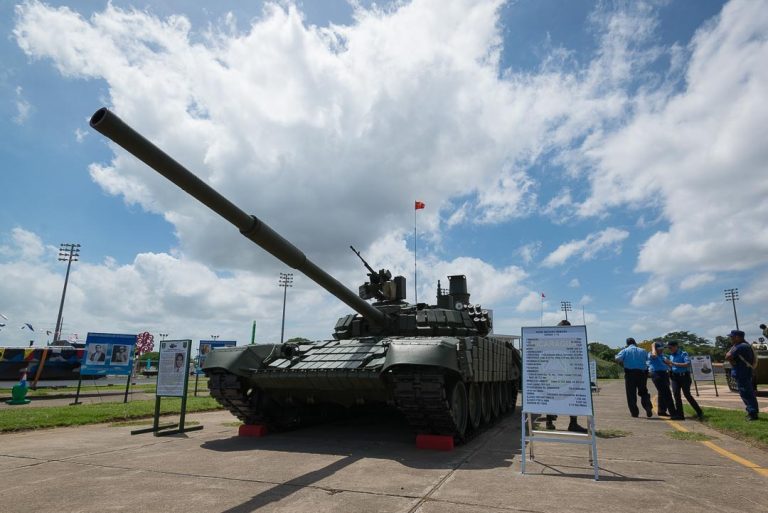19 de agosto 2016

Children of Exile: The Births “Sowing Hope” in the Camp of Nicaraguan Farmers

PUBLICIDAD 1M
PUBLICIDAD 4D
PUBLICIDAD 5D
Are the Russian T72 tanks that are replacing the T55 models new or factory refurbishments?

Gen. Julio Cesar Aviles, head of the Nicaraguan army, assured the public that the acquisition of 50 Russian T72 model tanks does not represent a US $80 million debt for Nicaragua, as the Moscow press asserted last April on the Sputnik news agency’s website.
Aviles stated that the tanks were acquired via a cooperation agreement between Moscow and Managua. “In the process of modernization and development [the acquisition] has taken place through a process of solicitation natural in the world of cooperation.”
The Russian embassy in Managua has maintained silence regarding these armored vehicles. Ambassador Andrey Vladimirovich Budaey’s assistant declared that the delegation “isn’t authorized to offer declarations in this matter.”
The army head reaffirmed that the Nicaraguan Army is in the process of modernizing, including the renovation of equipment, and that the T72 tanks that will replace “the old tanks that have outlived their usefulness. I’m talking about the T54’s and T55’s that are more than 35 years old,” Aviles stated in defense of the acquisition. He also spoke of the renewal of items in other areas.
Nevertheless, there’s no evidence that the recently acquired T72 tanks are actually new equipment. Diplomatic sources indicated to Confidential that the Russian tanks form part of an arms lot that has been utilized and discarded by the Russian army; after refurbishment, these are sent as donations to foreign countries.
The Nicaraguan army exhibited one of the Russian tanks during the military tactics exposition in the Plaza La Fe in Managua, part of the events marking the 37th anniversary of the Nicaraguan Armed Forces. The T72 tank is billed as the Army’s most modern weapon.
Several soldiers guarded the green colored tank from the scarce glances of the spectators who attended the exposition last Tuesday morning. The exposition will continue to be open as long as there is an adequate turnout of visitors, the press agent for the army event informed.
Bilateral cooperation relations between Managua and Moscow have strengthened since Ortega’s return to power in 2007. Buses, taxis, wheat and training for natural disasters have all been part of these agreements. Nonetheless, the aspect of military cooperation has awakened the greatest interest in this relationship.
President Vladimir Putin donated the first arms to Ortega in in 2012: a helicopter simulator and an anti-aircraft battery. In addition, Russia is installing the GLONSASS system, the equivalent of the North American global positioning system (GPS), and is planning the construction of a military training center for all of Central America. The construction of the GLONASS station in Nejapa was planned for May, but hasn’t yet begun.
Payment for “a foothold in Central America”?
According to the Russian news agency Sputnik, in addition to the tanks Russia will provide two Molnia 1241.8 missle launchers valued at 45 million dollars each.
In 2013, the Navy also ordered from the Russians four Mirazh 14310 patrol boats for the purpose of patrolling the Caribbean waters which the International Court of Justice declared under Nicaraguan sovereignty. That agreement included the delivery of Yak 130 fighter planes.
Security analyst Roberto Cajina stated that “this quote unquote donation” from Moscow could be interpreted as “payment” to Nicaragua for allowing the Kremlin to “get a foothold in Central America”
“There have been some signs of this… (Daniel) Ortega’s declarations in the Naval Forces ceremony hinted that they’re looking to have things given to them. I don’t believe that the United States would give him any more than what they’ve already offered,” Cajina maintained. “The idea is that Russia is carrying out geo-strategic movements in which Nicaragua has a bit part, and Ortega is facilitating this,” he added.
Cajina insisted that the acquisition of the 50 tanks has no “practical utility”, since Nicaragua has no conflicts on the visible horizon with either Honduras or Costa Rica. He reminded us that tanks are arms used in conventional warfare.
“Unless they want to use them as dissuasive arms in the interior of the country as happened in Tiananmen Square in China… If those who oppose the regime in Nicaragua go out into the streets, then Ortega is going to pull them out. But they have no real practical utility,” the security expert illustrated.
The exhibition also included war artifacts with the logo of Russia’s Emergency Ministry, known internationally as EMERCOM. Oleg Belaventsev, former director of this department who visited Nicaragua and met with Comandante Ortega in 2008, was the subject of a journalistic investigation for using these humanitarian aid contracts to benefit his own companies.
This article has been translated by Havana Times.
Read the original version here.
Archivado como:
PUBLICIDAD 3M
Periodista. Destaca en cobertura a violaciones de derechos humanos: desplazamiento forzado, tráfico ilegal en territorios indígenas, medio ambiente, conflictos mineros y ejecuciones extrajudiciales. Premio Iberoamericano Rey de España 2018.
PUBLICIDAD 3D